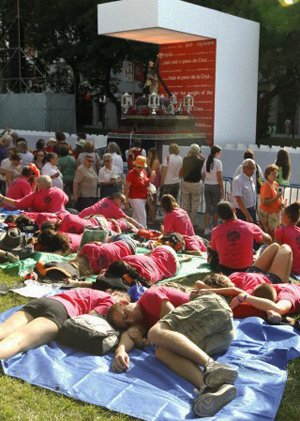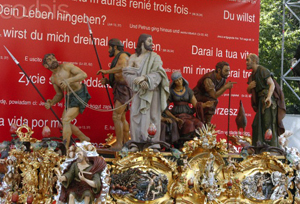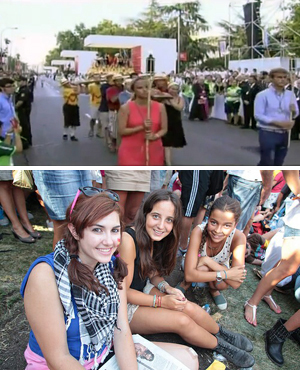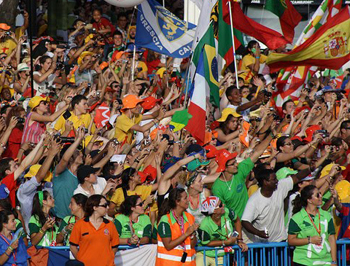 |
Traditionalist Issues
WYD Street Party & Stations of the Cross
Margaret C. Galitzin
A general carnival atmosphere prevailed during the festivities at the World Youth Day - 2011 in Madrid. “It feels like a universal street party hosted by the Catholic Church,” said one WYD reporter.

Young men and women rest together as they wait for the Stations to begin on Cibele Plaza | |
On Friday night, August 18, however, the party paused for the enactment of the Via Sacra in the Plaza de Cibeles, presided over by the Pope. Magnificent and solemn Holy Week statues from cities throughout Spain were set up along the street to illustrate each station, some guarded by confraternity members in ceremonial dress. The WYD Orchestra and Choir provided a backdrop of music.
It was an opportunity to introduce thousands of youth to a beautiful tradition of the Church that many do not know. Sadly, the effort was seriously flawed on two counts.
First, the traditional number and ordering of stations was changed. Not only were the 14 traditional Stations reordered, but some were left out and new scenes were introduced, such as The Last Supper, Judas’ Kiss and St. Peter’s Denial (stations 1 -3). Instead of the three falls of Christ, there was only one. During the commentary on that one Fall, the youth were told that the scene was not “biblical” and we can only imagine that it “probably” happened.
The second and more serious failing was the revolutionary content of the stations. This was not a traditional presentation of the Passion of Christ, who suffered and died to redeem man from the punishment due to sin. This was a progresivist-philanthropic Via Sacra, portraying Christ as suffering for “sins against humanity.” He was transformed into a model who relieves men from social injustice or the consequences of natural disasters. Videos explaining the meaning of the Via Sacra displayed documentaries about victims of terrorism, the ruins of Haiti, and, of course, Auschwitz.
This Way of the Cross “incorporated the trials and experiences of a universal Church,” the program bulletin stated. As the stations unfolded war, unemployment, racism, alcoholism and drug addiction were presented as the major “social sins” of our days, and pity was extended to immigrants and the religious and social outcasts. Representing these “marginalized” groups of society, groups of youth took turns carrying the large WYD cross. No dress code was enforced for participants in the ceremony and many girls who shouldered the cross were in shorts, mini-skirts or tight pants.
The first station, The Last Supper, was an effectual denial of the Catholic Faith as the only true faith. In it, an ecumenical call was made for all men to live together in peace, without religious harassment and discrimination. An appeal was added for all who believe in one God to live in justice and fraternity (The texts of the Cross for WYD 2011 Madrid).

Above, The Denial of Peter, a new WYD station; below first row, representing 'social sins' youth carry the cross; second row, a photo during the ceremony
 |
Personal sin was not even mentioned. Not a word about the torrent of venial and mortal sins committed in our days that caused Our Lord to suffer. Not a single plea for the infinite merits of Our Lord’s Passion to apply to our sins to lead us to contrition and repentance. No, the youth were called to consider only the “social sins.”
As the Stations continued, the commentary focused more sharply on “the dignity of man.” At the Death of Christ, the 11th station and apex of this novel Way of the Cross, the youth were told to ask themselves, “Am I working to spread and proclaim the dignity of the person and the gospel of life?”
Here, the youth were not reminded of the triumph of Christ over death or that Christ by His Sacrifice on the Cross ransomed us and reconciled us with God. They did not hear that Christ, the second Adam, offered His life on the Cross to redeen the guilt of the first Adam. Or that the slavery from which Christ purchased mankind through His death is the slavery of sin.
Instead, at the Taking of Christ from the Cross, the youth were told that Christ shares the fate of the victims of AIDS who need sympathy and help. Not a single word of censure of homosexuality, the main cause of AIDS. Not a mention that AIDS is a punishment for this sin that cries to Heaven for God’s vengeance.
This progressivist Via Sacra would not be complete without an indirect attack on Capitalism and the wealthy. It came at the 13th Station, when the Crucified Christ lies in the arms of His Mother. Then, the youth were asked to commiserate with parents who lose their children because of hunger, while “affluent societies, swallowed by the dragon of consumerism and materialist perversion, sink into the nihilism of their empty lives.”
As Christ was laid in His tomb, the youth were reminded of those suffering from catastrophes like tsunamis, earthquakes, hurricanes. Again, no mention that such acts were directed by God and could well be punishment for the sins of men.
Papal message

The crowd cheers the popemobile as the Stations end | |
Benedict’s message to the youth at the end of Stations was not counsel for them to stop sinning, to be chaste, to reform their lives, to profess the Catholic Faith and follow the Moral laws. Instead, he preached the gospel of man, affirming, “Christ’s passion urges us to take upon our shoulders the sufferings of the world.”
The message was that the good person, regardless of creed, is the one who serves mankind. He made no mention of the need to be in the state of grace, but emphasized the need to relieve the suffering of humanity. This is the way to salvation in the new man-centered religion of the Vatican II Church preached at the Via Sacra at WYD.
The stations ended, and the tone rapidly changed. As Benedict headed for the popemobile, the crowd cheered, a mass of bare arms waving in the air. Then, to the cheers of “Benedicto! Benedicto!” the Pope left Cibeles Square and the youth moved to the vast space of Cuatro Vientos for the vigil and big sleep-over. The street party continued.
The 15 WYD Madrid Stations:
1. Last Supper
2. Judas’ kiss
3. St. Peter’s Denial
4. Jesus is condemned to death
5. Jesus carries the Cross
6. Jesus falls beneath the weight of the Cross
7. Simon the Cyrene helps Jesus carry the Cross
8. Veronica wipes the Face of Jesus
9. Jesus is stripped of His garments
10. Jesus is nailed to the Cross
11. Jesus dies on the Cross
12. Jesus is taken down from the Cross
13. Jesus in His Mother’s arms
14. Jesus’ burial
15. Our Lady of Sorrows
|
 |
The 14 Traditional Stations:
1 - Jesus is condemned to death
2 - Jesus takes up His Cross
3 - Jesus falls the 1st time
4 - Jesus meets His mother
5 - Jesus is helped by Simon
6 - Veronica wipes Jesus' face
7 - Jesus falls the 2nd time
8 - Jesus speaks to the women of Jerusalem
9 - Jesus falls the 3rd time
10 - Jesus is stripped of His garments
11 - Jesus is nailed to the cross
12 - Jesus dies on the cross
13 - Jesus is taken down from the cross
14 - Jesus is laid in the tomb
|


Related Topics of Interest
 What’s Wrong with World Youth Day? What’s Wrong with World Youth Day?
 WYD-2005: No Sign That The Tide Has Turned WYD-2005: No Sign That The Tide Has Turned
 Stations of the Cross Changed for WYD-2008 Stations of the Cross Changed for WYD-2008
 And the Catholic Woodstocks continue... And the Catholic Woodstocks continue...
 ‘Papal’ Toilet Paper - A New WYD's Symbol? ‘Papal’ Toilet Paper - A New WYD's Symbol?
 Lack of Purity at Toronto WYD Lack of Purity at Toronto WYD
 On the New Morals Being Applied in the WYD On the New Morals Being Applied in the WYD

Related Works of Interest
|
Traditionalism | Hot Topics | Home | Books | CDs | Search | Contact Us | Donate

© 2002- Tradition in Action, Inc. All Rights
Reserved
|
 |
|